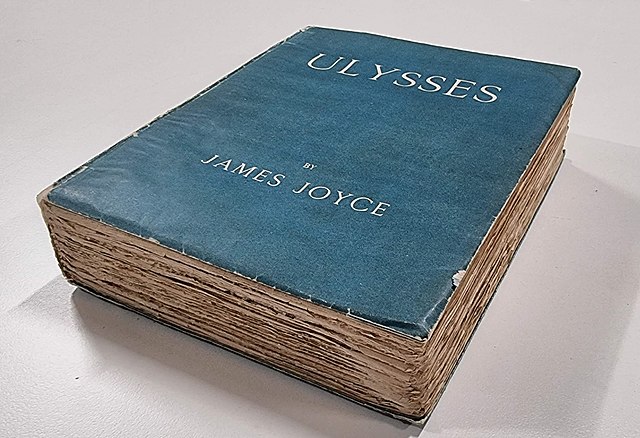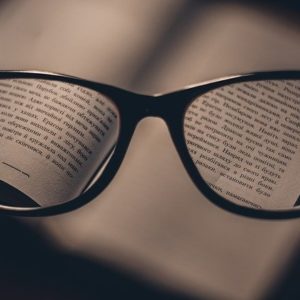James Joyce’s Ulysses is, famously, a difficult book. In grad school my professor introduced the novel by saying that most people who start reading Ulysses never finish it. Most of them, he said, won’t make it past the first paragraph of Episode 3. I’ve no idea what he said next, because I immediately turned to “Proteus” to see what was in store. I found out later that the opening lines bring us into Stephen Dedalus’ stream of consciousness. They read:
Ineluctable modality of the visible: at least that if no more, thought through my eyes. Signatures of all things I am here to read, seaspawn and seawrack, the nearing tide, that rusty boot. Snotgreen, bluesilver, rust: coloured signs. Limits of the diaphane. But he adds: in bodies.
To put it simply, Stephen is thinking about what and how he sees while walking on the beach. More precisely, he’s thinking about phenomenology and theories of sense perception—about whether color exists in the object-being-seen or in the eye, the organ of perception—in light of a number of texts by Aristotle and Bishop Berkeley.
You can see why so many people close the book there—and that’s a mere 31 pages into the 644-page Gabler edition of the text! But the text isn’t always so abstruse; in fact, it has a remarkably simple structure and object. Comprised of 18 episodes split into three parts, Ulysses follows the physical and mental peregrinations of Stephen Dedalus, Leopold Bloom, and Molly Bloom in Dublin over the course of 16 June 1904. While parts are difficult and even bizarre, the text isn’t a consummate slog. It’s fun to read, and it’s rewarding to readers.
While relating the events of 16 June 1904, Joyce simultaneously retells Homer, the Gospel of John, Dante, Hamlet, Paradise Lost, and more. The parallel with Homer is, perhaps, the easiest to discern. In addition to the title (Ulysses being the Latin name for Odysseus), Joyce himself explained some of the parallels in various schema he put together for friends who asked for help with the book. So in many episodes, Stephen corresponds to Telemachus, Bloom to Odysseus, and Molly to Penelope. But Ulysses is a book of many books: while the parallel with Homer is unfolding, we also see Stephen echo Hamlet and Milton’s Satan at turns. Thus the more you’ve read, the more you’ll find in Ulysses.
But the truly magnificent thing is the seamless way in which this is all woven together. Ulysses is a veritable encyclopedia, a bona fide microcosm of Joyce’s vision of the western literary tradition. And because of that, it just might change the way you read.
I quickly found I couldn’t escape Ulysses. I remember suffering epiphanies about Joyce while reading things as various as Homer and David Copperfield in the years immediately following my reading of Ulysses. My copy of Dante from my second bout of grad school is full of scribbles about Stephen and Portrait and Ulysses. I even have a copy of Hamlet devoted to Joyce.
But it’s not only the big texts in the western tradition which appear in some form or another in Ulysses. The text is so comprehensive it’s hard to say what it doesn’t engage or reference or rewrite. In fact, Joyce once joked, “I’ve put in so many enigmas and puzzles that it will keep the professors busy for centuries arguing over what I meant, and that’s the only way of insuring one’s immortality.” One of the exciting things about reading Ulysses, then, is the possibility of solving one of these puzzles or finding a connection with another text.
My favorite discovery in Ulysses involves Milton’s pastoral poem Lycidas. As Episode 2 opens, we learn that Stephen has the double misfortune of being poor and having to work as a schoolteacher. The text moves back and forth between the actual conversation in the classroom and Stephen’s internal thoughts. The scene will resonate with anyone who’s been in a classroom full of 8th or 9th graders. Stephen is asking his students a series of questions about Pyrrhus’ victory over the Romans at Asculum, but the lesson comes to a screeching halt when he calls on a doughy boy called Armstrong. Instead of paying attention, Armstrong has been attempting to surreptitiously eat figrolls. He says something stupid, lips covered in crumbs, and the class erupts in laughter.
That essentially ends the history lesson, and Stephen moves the class on to poetry recitation. He calls on Talbot to recite a portion of Lycidas, beginning at line 165, “Weep no more.” Talbot, thinking Stephen doesn’t notice, props his book open behind his satchel and begins to recite “jerks of verse with odd glances at the text.” Ulysses actually shows the first three lines of the recitation before following the wanderings of Stephen’s mind. While Talbot slowly and awkwardly cheats his way through the final two stanzas of Lycidas, Stephen begins thinking about history and contingency. He wonders what could have happened had Pyrrhus and Caesar not been assassinated, whether an infinite number of possibilities were rendered null or whether what actually happened were the only real possibilities.
It’s an interesting thing to think about in its own right, certainly more interesting than Talbot’s halting sham of a recitation, and Stephen’s mind wanders to a few phrases from Aristotle and the recollection of what happened when he read Aristotle in the library of Saint Genevieve in Paris. His attention is called back to Talbot because, having made it through 9 lines of Lycidas, he’s reached the end of the page and is trying to sort out how to turn the page without Stephen noticing. One of the amazing things about this short section of text is that it takes the same amount of time to read through Stephen’s thoughts as it does to read the 9 lines of Lycidas in a slow, disjointed manner. But that’s hardly the most impressive thing going on.
The few lines which are being read by Talbot but are not included in Ulysses turn out to be rather important. Here, Milton compares Lycidas’ death to the setting of the sun. Though the sun sinks into the ocean, he “anon repairs his drooping head, / And tricks his beams, and with new spangled ore / Flames in the forehead of the morning sky.”
Importantly, though the reader does not find these lines in Ulysses, Stephen would have heard them read aloud even as his mind wanders elsewhere. Though this occurs at the very beginning of the episode, there’s a subtle reference to the word “spangled” ten pages later in the episode’s closing sentence. In the interim, Stephen releases the class for field hockey, helps a student work through some math problems, and is waylaid by the headmaster, Mr. Deasy.
In short, it’s easy to come to the end of the episode having forgotten about Lycidas entirely. But as Stephen watches the light filter through the trees as Deasy turns away, he thinks, “On his wise shoulders through the checkerwork of leaves the sun flung spangles, dancing coins.”
This is the sort of reward Ulysses offers readers, and it’s available only to those who perform a close reading of other texts in light of Ulysses: a curious word that appears in a poem, which is only partially quoted, works its way into Stephen Dedalus’s beautifully crafted poetic description of sunlight playing on someone’s back and shoulders. Not only that, but “spangled” is a hapax legomenon in Joyce’s corpus. As far as I know, it appears nowhere else in Ulysses, Finnegan’s Wake, Portrait, or Dubliners.
Maybe that’s a small thing, but I find it so invigorating I think I’ll read Ulysses again—and maybe some more Milton.
Nathan M. Antiel lives in Raleigh, NC, with his wife and son. He has an MPhil from Trinity College Dublin, an MAR from the Yale Institute of Sacred Music, and teaches interdisciplinary humanities courses.





